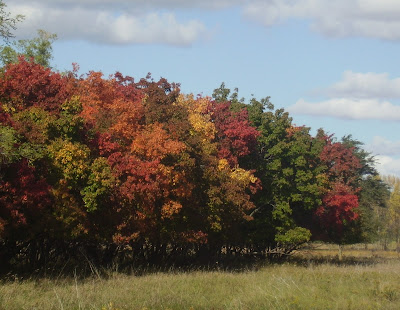Being out here on the prairie, we don't get the fall color visitation that the North Shore (of Lake Superior) has. I worked one fall at Gooseberry Falls State Park during the fall color rush -- holy moly, there was a ton of cars going through. I spent hours each day out in the parking lot just telling people where to find a parking spot.
Our prairie park has a lot of amur maple, which turn a beautiful bright red in autumn. It's really too bad they're considered an invasive exotic species for our area. The original amur maples were planted here thirty years ago by the state (!) as a windbreak for our office/shop area. Since then they have spread via seed and wind, clumps of small trees invading the prairie. We cut them down, but there are always more growing amidst the grass. I am loathe to cut the windbreak itself down because, after all -- a good windbreak is a good windbreak. And they do look very pretty in the fall. Even though they serve as a seed source for new tree growth. It is a bit of a dilemma, at least for me. So, right now we are just focusing on removing them from the open prairie.
It does make me wonder, however, what it is we're doing now that will be considered 'mistakes' thirty years down the road.
Our prairie park has a lot of amur maple, which turn a beautiful bright red in autumn. It's really too bad they're considered an invasive exotic species for our area. The original amur maples were planted here thirty years ago by the state (!) as a windbreak for our office/shop area. Since then they have spread via seed and wind, clumps of small trees invading the prairie. We cut them down, but there are always more growing amidst the grass. I am loathe to cut the windbreak itself down because, after all -- a good windbreak is a good windbreak. And they do look very pretty in the fall. Even though they serve as a seed source for new tree growth. It is a bit of a dilemma, at least for me. So, right now we are just focusing on removing them from the open prairie.
It does make me wonder, however, what it is we're doing now that will be considered 'mistakes' thirty years down the road.
The cattails are so rich in color right now. In the fall, the grasses usually outshine the trees on the prairie.
Here is one of our restoration fields. You can see the big blue stem has established itself well. This grass reaches about five feet tall. I'd love to have seen the vast stretches of tall grass prairie that were on this land hundreds of years ago.
The leaves of the big blue stem change color in the fall, just as lovely as the leaves on a tree. Just not as showy -- you have to look down to see the color, not up. The stem itself turns an amazing shade of dark purple.
And while you're looking down, you can see a few other things too.
These little asters are about the only flowers still in bloom. (Unless you count the occasional thistle, dandelion or spurge which never seem to STOP blooming...)
Most of the trees in this area turn yellow in the fall--elms, ashes and cottonwoods. The trees are just about past peak already. My fall color report for next week will reflect these changes. With our high winds, the leaves don't stay on the trees very long after they begin to turn. But the colors are lovely while they last.








6 comments:
Thanks for the lovely fall tour. Makes me want to get out right around home here to see more of it before our winds take all the leaves.
Beautiful post Jo, thanks for sharing!
That hit the spot ~ really needed some Minnesota autumn this week. I look forward to the updated reports! Cheers and thanks.
I didn't know about amur maples. Sounds like our kudzu in the South. Brought in by the government and now considered a week! Beautiful color though. I love your prairies.
Beautiful pics Jo!
Thanks all of you! From what I know of kudzu, our maple trees aren't nearly as devastating. Guess I'd rather have the maples!
Post a Comment